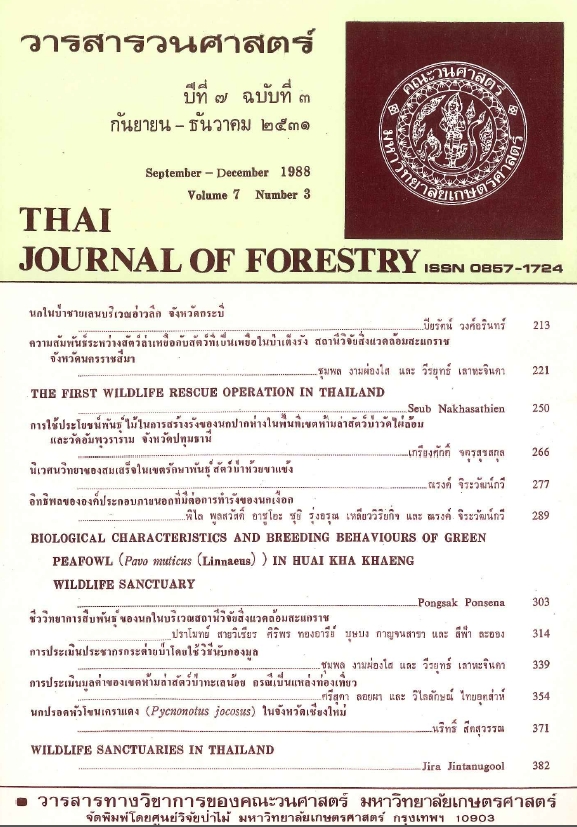BIOLOGICAL CHARACTERISTICS AND BREEDING BEHAVIOURS OF GREEN PEAFOWL (PAVO MUTICUS (Linnaeus)) IN HUAI KHA KHAENG WILDLIFE SANCTUARY
Main Article Content
บทคัดย่อ
The study on the biological characteristics and breeding behaviours of green peafowl (Pavo muticus (Linnaeus)), which was carried out in Huai Kha Khaeng Wildlife Sanctuary, Changwat Uthai Thani and Changwat Tak, from October 1986 to October 1987, revealed that the green peafowl of this sanctuary is the Indo-Chinese green peafowl. This bird is commonly found in the mixed deciduous forest, dry dipterocarp forest, secondary forest, small patches of dry evergreen forest, salt licks and ponds in the forests. During the breeding season, this bird population usually comes to aggregate along the main streams which have sand bars and point bars. Its home range size in breeding season was 148 hectares. Green paefowl is a diurnal bird, roosting in trees but feeding on the ground. It begins to forage at 07.00 a.m. rests in sheltered area at about 10.00-10.30 a.m. and forages again at 04.30 p.m. It feeds on at least 66 species of plants. Besides that it feeds on insects and small vertebrates. Generally, the roosting times range from 06.00-07.30 p.m. in groves of tall trees near the riversides. The mating type of the green peafowl is polygamous and had a breeding season which lasts from November to March. The peahen nests on the ground in the forest or in high grass patches along the riversides. Clutch size ranges from 2-5 eggs with an incubation period of 26-27 days. The average population structure of adult male: adult female: immature bird in the breeding season was 1.00: 3.84: 0.67. The green peafowl has many types of relationships with other wildlife in the same habitats, but 2 main types are commonly recognized, symbiosis and predation.
Downloads
Article Details

อนุญาตภายใต้เงื่อนไข Creative Commons Attribution-NonCommercial-NoDerivatives 4.0 International License.
ข้าพเจ้าและผู้เขียนร่วม (ถ้ามี) ขอรับรองว่า ต้นฉบับที่เสนอมานี้ยังไม่เคยได้รับการตีพิมพ์และไม่ได้อยู่ในระหว่างกระบวนการพิจารณาตีพิมพ์ลงในวารสารหรือสิ่งตีพิมพ์อื่นใด ข้าพเจ้าและผู้เขียนร่วม (ถ้ามี) ยอมรับหลักเกณฑ์และเงื่อนไขการพิจารณาต้นฉบับ ทั้งยินยอมให้กองบรรณาธิการมีสิทธิ์พิจารณาและตรวจแก้ต้นฉบับได้ตามที่เห็นสมควร พร้อมนี้ขอมอบลิขสิทธิ์ผลงานที่ได้รับการตีพิมพ์ให้แก่วารสารวนศาสตร์ คณะวนศาสตร์ มหาวิทยาลัยเกษตรศาสตร์ กรณีมีการฟ้องร้องเรื่องการละเมิดลิขสิทธิ์เกี่ยวกับภาพ กราฟ ข้อความส่วนใดส่วนหนึ่ง หรือ ข้อคิดเห็นที่ปรากฏในผลงาน ให้เป็นความรับผิดชอบของข้าพเจ้าและผู้เขียนร่วม (ถ้ามี) แต่เพียงฝ่ายเดียว และหากข้าพเจ้าและผู้เขียนร่วม (ถ้ามี) ประสงค์ถอนบทความในระหว่างกระบวนการพิจารณาของทางวารสาร ข้าพเจ้าและผู้เขียนร่วม (ถ้ามี) ยินดีรับผิดชอบค่าใช้จ่ายทั้งหมดที่เกิดขึ้นในกระบวนการพิจารณาบทความนั้น”


